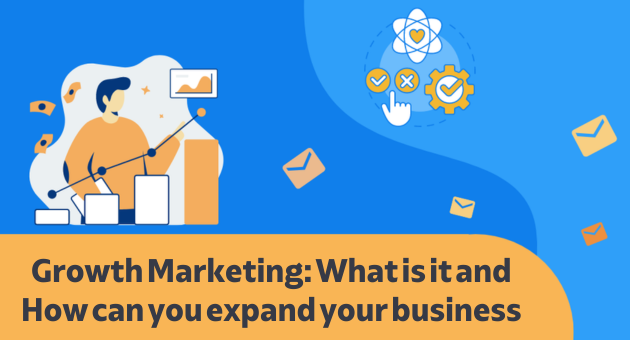
Growth marketing: boost your business growth
Growth marketing, Growth Hacking, Brand Marketing… marketing encompasses so many concepts and they all sound so similar that it’s easy to get confused.
That’s why we prepared an article to talk about Growth Marketing, a branch of marketing focused on growth.
Below we explain what Growth Marketing is and how it differs from other types of marketing and how to create your own strategy to improve your business results.
And for you to understand this concept more clearly, at the end of the article we will also give three examples of successful Growth Marketing strategies that helped the companies that put them into practice.
Let’s start? 📈
- 1 Growth marketing: boost your business growth
- 2 What is Growth Marketing?
- 3 Objectives of Growth Marketing
- 4 What do Growth Marketers do?
- 5 Growth Hacking vs. Growth Marketing
- 6 Brand Marketing vs. Growth Marketing
- 7 How to create a Growth Marketing strategy for your company
- 8 3 Examples of Growth Marketing
- 9 Are you ready to expand your business through Growth Marketing?
What is Growth Marketing?
If we had to set a definition of Growth Marketing we would say it is a combination of marketing tactics such as SEO, email marketing, content marketing, product marketing or affiliate marketing, among others, directly focused on the growth of your business.
And this growth happens at all stages of the sales funnel, from capturing leads to customer conversion, retention and loyalty.
The main difference between Growth Marketing and Traditional Marketing is in its goals. This is why in the next few paragraphs we will talk a little more about these points 👇
Objectives of Growth Marketing
While traditional marketing focuses on promoting the brand, Growth Marketing guides your action towards more concrete objectives that aim to boost your business more directly.
- The company’s sustained growth through the fulfillment of its commercial goals.
- The search for new customers to increase business revenue.
- Build long-term relationships with existing buyers to save lead acquisition costs and increase customer life cycle.
- Consumer engagement with the company to convert them to brand ambassadors and convince customers to recommend the company to their friends.
What do Growth Marketing professionals do to achieve these goals? Keep reading, because that is exactly what we will explain below.

What do Growth Marketers do?
Online advertising, user experience, SEO … Growth Marketing uses many techniques and strategies, and Growth Marketers who apply them should be experts in these techniques.
These are the techniques that these professionals need to master:
- Digital marketing strategies. Plan strategies adapted to audience behavior and preferences at any time, aiming at growth through customer acquisition, retention, loyalty and recommendation.
- Online advertising strategies. Studying different online advertising channels such as advertisements on social media, search engines or graphic advertising- multimedia ads in advertising spaces on blogs, websites or portals- and design strategies and advertising campaigns in the best media for the company.
- SEO. Improve brand ranking on search engines through the website, blog and other online channels organically; That is, without paying for advertising.
- Social media. Manage social media accounts to improve the company’s reach, popularity and ranking and attract new customers.
- Improve the user experience. User Experience (UX) is critical when it comes to attracting and retaining customers for your brand. UX designers, product experts, and CRO (Conversion Rate Optimization), design and optimize the user experience throughout the customer’s journey to improve conversion.
As you can see, Growth Marketing is not a single marketing technique, but there are many possible ways to apply it and many possible Growth Marketer profiles within a company.
However, not all actions usually associated with Growth Marketing really are; Let’s see the differences between Growth Marketing and other techniques that are often confused with this type of strategy.
Growth Hacking vs. Growth Marketing
Growth Hacking is a part of Growth Marketing. But while Growth Marketing describes long-term strategies to create lasting relationships with customers, Growth Hacking is a more experimental marketing that seeks short-term results.
The goal of Growth Hacking is to find ways to increase ROI in the shortest possible time.
To achieve it, marketers will continually try new actions, such as offering different types of content or advertising, making changes to the site or product design, testing new acquisition channels… Always looking for hacks, tricks or shortcuts that allow them to get fast results.
And if they don’t get results, they will quickly discard this alternative and try a new one.
In short: the focus of Growth Hacking is to discover, test, and optimize tactics that become “levers” for short-term growth.
Let us now look at the differences between Growth Marketing and other types of marketing that are often confused with it.

Brand Marketing vs. Growth Marketing
The goal of brand Marketing is to value a company’s brand, enhance its recognition and associate it with concepts related to its values and vision.
Thefore Brand Marketing focuses more on transmitting the brand in a way that connects with the audience, while Growth Marketing will seek the company’s financial growth through relationships with its customers throughout the entire funnel – from acquisition to loyalty, going through all intermediate phases.
Now that you know what Growth Marketing is- and what it is not- let’s explain something that will surely interest you: how to create your own Growth Marketing strategy.
How to create a Growth Marketing strategy for your company
The first step towards the success of any marketing strategy is planning, and in this section we will explain how to create a strategy to apply Growth Marketing techniques that will boost your business growth.
Define your target audience
Your customer must be at the center of your strategy, so the first thing you should do when planning your Growth Marketing strategy is to create a detailed profile of the person who will buy your product or service.
This profile should include information such as gender, age, location and education or income level.
To further refine your customer’s strategy and content, after defining your target audience, research within this more specific niches that are interested in your product or service.
For example, if you sell sports equipment to women, within this segment there may be women who practice various types of sports, sports centers who teach women or even personal trainers.
Each of these groups will have different needs related to your product, and knowing them will help you guide your strategy and actions more effectively.
Try to understand your potential customers
For the best results, it is important to have a lot of information about your customer. How can you get it? You would need to follow these steps:
- Talk to your customers. The best way to get information about your target is to go directly to the source; surveys or interviews are a very effective way to discover everything possible about your customer, their needs and interests, what they are looking for, and how you can help them.
- Practice social listening. Social media platforms are an infinite source of information about customers and the competition. You should monitor them to get more information about your audience.
- Analyze the feedback you receive from your consumers. Any interaction your buyers have with your brand through channels such as customer service, emails or chat on your website is an opportunity to obtain feedback with valuable information for your company’s growth marketing strategy. business.
This information will allow you to take your buyer persona into account and plan your Growth Marketing strategy more efficiently.
Choose the most appropriate strategies and actions
After understanding who your ideal client is, you should identify what are the best communication channels, which social media platforms they use and the type of content they consume.
This will allow you to focus your strategy on the most appropriate platforms and project the most appropriate content and actions to achieve your goals and expand your business.
Let’s see an example of these possible actions.
Articles for your blog
If your audience include many blog readers, focus on creating an editorial calendar with interesting content for them and aligned with your growth goals.
If, for example, you would like to promote a specific product, consider publishing a series of articles related to it, with information on how this product could solve the problems your consumers may be facing.
Remember that the goal here is not to publish promotional content, but articles that help your customer solve the same problems that can be solved with your product.
Also remember to optimize this content for SEO so that your audience can find it more easily – when they are searching for information related to their problem. The same rule is also applicable to your site, of course.
To do that, you can use different SEO tools to study the keywords your customers are using to search for products like yours on the internet. Thus, if you can improve website ranking, you will attract more visitors and the conversion rate will increase; at the end of the day, more leads will mean more sales.
Email marketing
Email marketing is one of the most effective marketing tools as it allows a very close contact with your audience.
In addition, when you are creating email marketing campaigns, you can customize your newsletters to different customer profiles, as well as refine your message as much as possible and increase your business growth.
Display advertising
The internet is full of advertising spaces on different types of pages, such as newspapers, blogs, websites or portals, among others.
Referral programs
Another option to expand your business is to get recommendations from your customers. And is there any better option than encouraging your customers to recommend your products?
Referral programs reward customers who bring new consumers to your brand. You can offer free discounts, services or any other advantage you deem enough relevant to them.
Measure and track the results
Statistics are the key to understanding whether your Growth Marketing strategy is working or you need to make changes; tracking your results will show ways to improve your actions, so that you can create new campaigns.
You can use metrics such as the number of visitors to your website or blog, the number of converted customers, the number of new subscribers and newsletter open rates, among many others.
Do you want to see how to apply a Growth Marketing strategy in detail? In the next section, we will see some examples of Growth Marketing techniques applied by large multinational companies.

3 Examples of Growth Marketing
Growth marketing techniques work for small and medium businesses, as well as for large companies. Here are three examples of this type of strategy that companies you probably know have applied.
1 Amazon and Retargeting
How many times have you seen ads showing the same products that you had previously searched for on Amazon?
We were talking about this when we explained what is display ads. Amazon uses your web browsing data to show you ads for products you’ve searched for but that they know you haven’t yet purchased.
This technique helps increase their sales, and this is exactly what Growth marketing can do for your company.
2 DROPBOX and its referral program
Dropbox is one of the classic examples of Growth Marketing through a referral program .
How did Dropbox jumped from 100,000 users to four million in just 15 months? Very simple: they offered storage space.
In this case, through a referral program that rewarded existing and new customer with 500 MB of free storage; customers had to recommend the software to a friend to get more free space. Thus, users were rewarded and the brand too, as the company grew stratospherly.
3 Booking and Remarketing by Email
We said before that email marketing works very well. And if you are sending subscribers a discount, it works even better.
Booking uses Growth Marketing by email to send special offers to people who sought accommodation in their Online reservation platform.
The campaign targeted users who already searched for the product, so the result was amazing.
A very effective technique to increase the number of reservations.
These are just three examples, but there are many others you can replicate to expand your business. Are you ready to start using this strategy?
Are you ready to expand your business through Growth Marketing?
You’ve seen Growth Marketing is a very effective way to get higher income for your business. And also that email marketing remains, many years after its creation, one of the most effective tools to achieve it.
A good email marketing strategy allows your customers to target as much as possible and customize your emails with the most suitable content to achieve your goals.
And that’s exactly what Mailrelay offers: a tool you can use to attract and retain customers to expand your business by applying Growth Marketing techniques with email marketing.
👉 Try our email marketing software and start taking advantage of Growth Marketing to increase your business growth.